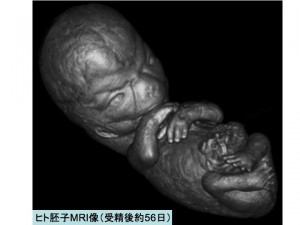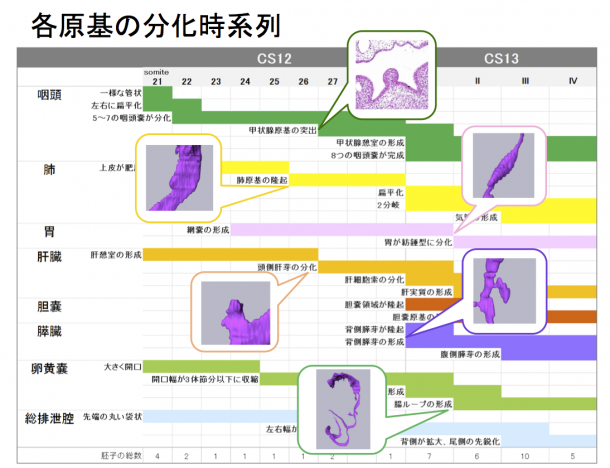
ヒト胚子透過立体回転画像が知的財産に登録されました。おもにMRIで撮像されたCS13-23の胚子を、コンピュータを用いて立体化したものです。一部は日本科学未来館で展示される予定です。
|
||||
|
ヒト胚子透過立体回転画像が知的財産に登録されました。おもにMRIで撮像されたCS13-23の胚子を、コンピュータを用いて立体化したものです。一部は日本科学未来館で展示される予定です。
修士論文審査が行われました。落ち着いてわかりやすく発表でき、良かったと思います。諮問も問題なく終了です。
ヒト聴覚器の各発生段階の形態学的解析 背景:ヒトの聴覚器は、内耳、中耳、外耳に分けられる.その発生過程については、これまで組織切片を用いた観察が主体であり、立体像を用いた解析は膜迷路でしか行われていない.また、現在ヒト発生学での発生段階の指標として用いられているカーネギーステージ(Carnegie Stage(CS))分類の提唱以前に行われているものが多いため、CSに沿った報告が少ない. 目的:ヒト胚子の連続組織切片を用いて立体像を作成し、胚子期における内耳、中耳、外耳それぞれの各CSにおける形態的特徴と、相互の位置関係を明らかにする. 対象・方法:京都大学大学院医学研究科附属先天異常標本解析センターに保存されている外表の状態から正常と判断され、かつ、保存状態が良好なヒト胚子の連続組織切片17個体(聴覚器33例)を用いて聴覚器の立体像を作成し,CSごとに発生過程の観察を行った. 結果:①内耳 半規管:CS18(4個体、聴覚器8例)では、3例で半規管が全く形成されておらず、1例で後半器官のみ、1例で前半規管のみ、3例で前半規管と後半規管の2つが形成されていたが、CS19以降の個体では全例で3つ全ての半規管が観察された.蝸牛管:CS18(4個体、8例)では、6例で蝸牛管の回転は観察されず、2例で回転方向(上向き)に曲がりL字型になっていた.その後徐々に回転が進み、CS19(3個体、6例)の2例で半回転、CS20(2個体、4例)の全例で1回転、CS21(4個体、8例)の2例とCS22(3個体、5例)の全例で1回転半、CS23(1個体、2例)の全例で2回転していた.卵形嚢と球形嚢:CS22(3個体、5例)の3例とCS23(1個体、2例)の全例で球形嚢と卵形嚢を明確に区別することが可能であった.②中耳 耳小骨:アブミ骨はCS18(4個体、8例)の2例ですでに輪の形が形成されていたが、CS23までの全例でアブミ骨底が観察されなかった.ツチ骨とキヌタ骨は、CS19(3個体、6例)の4例で原基が観察でき、CS23までに成人のものとほぼ同様の形態がつくられていた.また,キヌタ・ツチ間の関節面はCS19(3個体、6例)の2例で接しており、キヌタ・アブミ間の関節面はCS21(4個体、8例)の7例で接していた.耳管:耳管は全CSの全例で正面から観察すると平たく、側面から観察すると、耳介へ向かって広がる裂隙状であった.③外耳 外表形態:Streeter G. L.による耳介の形態分類を参考に分類を行ったところ、時系列に沿った形態が観察されたが、左右で形態に差をもつ個体が6個体存在した.④相互関係 耳小骨と内耳:側面から観察した際、CS20までは全例とも、耳小骨が蝸牛管の回転始起部付近で前後方向にずれて存在していたが、発達段階が進むにつれて徐々に近づき、CS22以降の全例で、耳小骨が前庭付近で互いに重なり合って存在していた.CS23では、全例でアブミ骨が球形嚢部分に接していた.耳管と外耳道:CS19では耳管に対して低い位置に存在する外耳道が,発達段階が進むにつれて徐々に耳管に接近していた. 結論:本研究で,CS18からCS23までの聴覚器の立体像を作成し,各CSのそれぞれの発生過程と相互関係が明らかになった.今回,正常個体の発生過程が明らかになったことにより,先天的な聴覚器の異常の早期発見につながることが期待される 21. Ozeki-Sato M, Yamada S, Uwabe C, Ishizu K, Takakuwa T, Correlation of external ear auricle formation with staging of human embryos, Congenit Anom (Kyoto) 56, 86-90, 2016, DOI: 10.1111/cga.12140, (概要) (外耳形態の部分) 26. Ozeki-Satoh M, Ishikawa A, Yamada S, Uwabe C, Takakuwa T. Morphogenesis of the Middle Ear Ossicles and Spatial Relationships with the External and Inner Ears during the Embryonic Period, Anat Rec (Hoboken) 299:1325–1337, 2016, DOI 10.1002/ar.23457, (概要) (中耳骨の形成と内耳・外耳・耳管との空間的関連性) The digestive tract and derived primordium differentiate by following a precise timeline in early human embryos  22. Ueno S, Yamada S, Uwabe C, Männer J, Shiraki N, Takakuwa T, The digestive tract and derived primordia differentiate by following a precise timeline in human embryos between Carnegie stages 11 and 13, Anat Rec (Hoboken) 2016, 299, 439-449, DOI: 10.1002/ar.23314s, (概要)
私たちが研究に利用しているヒト胚子の解析画像が「日本科学未来館; 東京江東区」に提供されることになりました。 ヒト胚子期のMRI画像から再構成した立体画像です。 2015年春に生命に関する常設展に使用される予定です。今から楽しみです。 12/5-8、および12/13-14にPhoton Factory (つくば)で位相X線CTを用いて胚子撮像を行いました。今年度の撮像はこれで終了です。得られた画像は、胚子の詳細な内部観察に使用します。 発達神経科学会第3回学術集会で発表しました。(2014.10.16-17; 東京) ヒト胚子における Willis 動脈輪の形成について 小池哲平、山田重人、上部千賀子、高桑徹也 ヒト胚子期における脳形態形成の解析 白石直樹、片山愛里、中島 崇、上部千賀子、巨瀬 勝美、山田 重人、高桑 徹也 高石くんの卒業論文「膝関節の形態形成; EFICを用いた3次元的解析」がOsteoarthritis Cartilage ( 特集号Imaging in Osteoarthritis)に掲載されました。 9. Takaishi R, Aoyama T, Takakuwa T, et al; Three-dimensional reconstruction of rat knee joint using episcopic fluorescence image capture, Osteoarthritis Cartilage, 2014; 22(10), 1401-1409. 10.1016/j.joca.2014.06.016
SummaryObjectiveDevelopment of the knee joint was morphologically investigated, and the process of cavitation was analyzed by using episcopic fluorescence image capture (EFIC) to create spatial and temporal three-dimensional (3D) reconstructions. MethodsKnee joints of Wister rat embryos between embryonic day (E)14 and E20 were investigated. Samples were sectioned and visualized using an EFIC. Then, two-dimensional image stacks were reconstructed using OsiriX software, and 3D reconstructions were generated using Amira software. ResultsCavitations of the knee joint were constructed from five divided portions. Cavity formation initiated at multiple sites at E17; among them, the femoropatellar cavity (FPC) was the first. Cavitations of the medial side preceded those of the lateral side. Each cavity connected at E20 when cavitations around the anterior cruciate ligament (ACL) and posterior cruciate ligament (PCL) were completed. ConclusionCavity formation initiated from six portions. In each portion, development proceeded asymmetrically. These results concerning anatomical development of the knee joint using EFIC contribute to a better understanding of the structural feature of the knee joint. |
||||